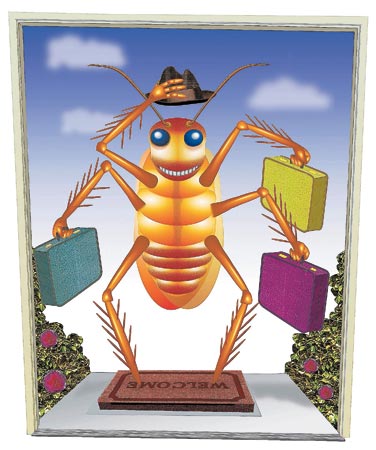Before spraying wildly at anything that moves, consider more reasoned approach
To borrow a famous line from a classic horror movie: They're baaack.
Every year about this time, when the temperatures go up and the humidity goes down, valley residents receive some uninvited, unwelcome visitors. And we're not talking about those annoying high school friends who only want to crash on your couch while they hit the pool party scene.
These visitors are of the six-legged -- and occasionally, eight-legged -- variety, those creepy crawlies that instill so much fear in people that they really should have been incorporated into some kind of weapon by now. Cockroach bomb, anyone? Or maybe a spider gun?
Arthropods, specifically insects and arachnids, vastly outnumber humans, notes M.L. Robinson, an environmental horticulturist and professor at the University of Nevada Cooperative Extension. So there really is nothing you can do about their existence on planet Earth. Or even in Southern Nevada.
But with the right approach, you can do something about your backyard and your home, arthropod experts say.
First, you have to figure out whether you actually need to do something.
While there are thousands of species of arthropods in Nevada, only a handful present local residents with a problem during summer months: cockroaches, ants, earwigs, scorpions and cicadas. Of course, there are crickets, moths, beetles and other bugs, but those five are the ones that state entomologist Jeff Knight hears about most at this time of year.
What bugs bug you also depends on what part of town you live in, says Bob Stauffer, who has a Ph.D. in agriculture and has studied insects and natural pest control for years.
Keep in mind that 25,000 to 30,000 arthropod species live in Nevada, Robinson says, and there are 10 million species worldwide. In comparison, 200 to 400 species of birds are found in the state.
"There are so many that if they wanted to overtake us, they could," Robinson jokes.
Scared yet?
Lots of people are, says Knight, who only chuckles at the idea of fearing or hating a cockroach.
"Some people see something with six legs running across the floor and they think it's bad," Knight says.
That's not necessarily the case. It could be that the front door was left open and a roach scurried in. Many insects and arachnids come in from outside.
Often, homeowners want to spray indiscriminately when they see a bug, Knight says, and that's their right. It isn't always the best approach, however.
Knight and Robinson both suggest an integrated pest management system, or IPM. That's where you indentify what you have and use the least toxic method of control, working your way up until you achieve a relatively pest-free home.
It helps if you set out traps to gauge whether you have an infestation. If you don't catch a lot of bugs, you probably don't have a pest problem, Robinson says. If you do catch something, identify it before you try to eliminate it.
As part of his job as state entomologist, Knight identifies insects for Nevada residents free of charge. Southern Nevadans can either e-mail a photo of the bug they need to identify to jknight@agri.state.nv.us or send a sample to the Nevada Department of Agriculture through the local office at 2300 McLeod St. Knight will then recommend approaches that homeowners can use.
"When people call me up, I find out what direction they want to go and then try to go in that direction," Knight says.
Sometimes, people don't want to use pesticides; that's when he suggests natural insecticides such as diatomaceous earth or boric acid.
His first, most important recommendation is to eliminate the reason insects are in the house.
Cockroaches, earwigs, ants and even scorpions go inside looking for food and water. If you have an insect problem, then you probably have a food source that they use.
Keep garbage cans clean and pet food and water dishes off the floor. Dirty dishes in the sink or dishwasher can be attractants, too.
If you don't address the insects in the yard, though, you probably will continue to have a problem. Eliminate hiding places outside -- piles of vegetation, stacks of wood or anything sitting near a door -- and use an insecticide to treat the perimeter around the house and yard.
Those who want to hire a professional can do that, as well. Knight and Robinson recommend that you ask companies you are considering whether they practice integrated pest management. If not, ask why.
Contact reporter Sonya Padgett at spadgett@reviewjournal.com or 702-380-4564.
more bugs and hints

















